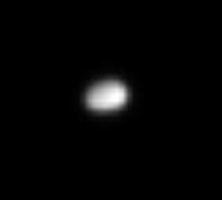
|
Flamsteed Astronomy Society |
|
‘The Cassini Probe and Saturn’s Rings’ by Prof Carl Murray - November 14, 2011 |
|
page 2 of 2 |

|
Continued...
> Evidence for orbital evolution of Bleriot “propeller moon” There are many “propeller moons” which are too small to be seen but which create disturbances within Saturn’s rings, such as Bleriot in the ‘A’ ring. > Daphnis in the Keeler gap > Regular structure across D & C rings > Several images of the F rings between 2006 & 2008 showing jets and variations in the F ring shape > Finally, a slide showing a new moon of Saturn: the discovery of Polydeuces Carl then discussed a most interesting topic: “How to discover a Moon”, detailing the following required steps:- > Initial detection of a moving object > Check that it behaves in accordance with Kepler’s Law > Draw preliminary orbit, check that it is a freely precessing ellipse > Additional detections > Draw improved orbit > Fit observations to numerical integration > Produce “final” orbit > Detect it again! There then followed a short sequence showing the discovery of the moon Anthe on 22 June, 2007, followed by another sequence showing Anthe’s orbital evolution. And finally, in a lighter vein to wind up the lecture, Carl projected two slides: His room when an undergraduate at Queens’ University, Belfast; and a picture of him standing next to Richard Garriot (astronaut and visitor to the ISS) and Buzz Aldrin (lunar module pilot of Apollo 11). One more fascinating snippet of information from Carl before closing the lecture: The Cassini Mission is now expected to end in 2017 – a long way past its planned service expiry date of 2008! As befits such an absorbingly interesting lecture, many questions were thrown up from the floor of the packed lecture hall, to which Carl responded with his usual clarity and humour.
|

|
Prof Carl Murray [Pic Mike Dryland] |


|
Prometheus and the F ring
|

|
Polydeuces
|
|
Tracking a ‘propeller’
|

|
Anthe’s faint arc |